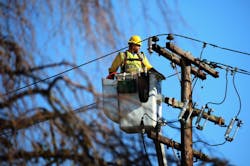PSEG Long Island Upgrades Grid to Protect Customers from Future Storms
PSEG Long Island has made significant improvements to the transmission and distribution infrastructure, storm process, technology and customer communications since Superstorm Sandy made landfall five years ago.
Superstorm Sandy and the Nor’easter that followed caused nearly all of the service territory’s 1.1 million customers to lose power. The entire service territory was declared a federal major disaster area. Power was lost as a result of flooding, downed and up-rooted trees, damaged switching and substations, and significantly damaged poles and electrical equipment.
“Our employees are working across Long Island and the Rockaways to continue to upgrade and strengthen the electric system to provide customers with safe reliable service,” said John O’Connell, vice president of transmission and distribution, PSEG Long Island. “New up-to-date equipment is being installed across 320 circuits to modernize the electric grid and help to mitigate outages and curtail restoration time during storms.”
More than $729 million of federal recovery funds was secured via an agreement between Governor Andrew M. Cuomo and the Federal Emergency Management Agency (FEMA), under the FEMA Hazard Mitigation Assistance Program. This project has permitted PSEG Long Island to execute substantial storm hardening improvements including flood mitigation, stronger infrastructure, and smarter transmission & distribution equipment.
The utility has also transformed its communications strategy and implemented a more robust vegetation management program to minimize storm damage and improve the experience for its customers.
Flood mitigation
Superstorm Sandy brought unprecedented storm surges and flooding that swept over all precautions put in place and caused tremendous damage to substations that provide electricity to individual neighborhoods. When the repairs and upgrades began, PSEG Long Island incorporated new storm surge prediction models to set new standards for elevating crucial equipment. The 12 substations affected by the storm have been upgraded and elevated to protect against flooding in the future.
Stronger infrastructure
In the months and years following Superstorm Sandy, PSEG Long Island evaluated the electric system and the damage that occurred to find ways to improve the design of the infrastructure to integrate new construction standards and help mitigate future storm damage. The improvements include, stronger poles-to withstand winds up to 135 mph, thicker insulated wires-to protect against tree limbs causing an electric problem in the event of contact, shorter cross arms-to move the lines closer together and help deflect falling limbs.
Smarter transmission & distribution equipment
Automatic switching units, a smarter technology, have been installed on targeted circuits across Long Island and the Rockaways. This automated technology transmits more data to the control room to help minimize the number of customers affected when equipment fails. By the time the FEMA-funded work is complete, PSEG Long Island expects to install up to 1,000 automatic switching units.
PSEG Long Island has also implemented a new outage management system (OMS) to improve the company’s ability to identify and manage outage conditions all year long. The OMS also expands the ability to respond and coordinate resources in the aftermath of a major storm.
Sandy’s strong winds brought down many trees across Long Island. Even smaller storms can bring vegetation in contact with overhead lines. To further minimize storm damage to the electric system, PSEG Long Island’s tree trimming program works throughout the year to identify and trim tree limbs in rights of way and along easements that could potentially cause outages during or after a storm. Tree limbs that come in contact with electric lines remain a major cause of customer outages during storms. Since 2014, trees have been trimmed from more than 7,700 miles of distribution lines and 950 miles of transmission lines.
Communicating with our customers
Superstorm Sandy revealed a critical need for the utility to enhance communications with customers. To address this need, PSEG Long Island launched a new, voice-activated automated customer service telephone system to record and report outages to system operators. This system is easier for customers to use and makes the restoration process quicker and more efficient.
Customers now have access to a new enhanced outage map for both mobile and desktop devices. This map lets customers view outages, and get updates on estimated restoration time and crew locations. Customers can also report outages through social media, or sign up for My Alerts and receive outage updates via text, email and phone.
Communication means more than being there for customers when their power is out. PSEG Long Island’s emergency response plan has increased focus on stakeholders at every level. Before, during and after a storm lands, there are coordination calls with municipalities, liaisons are located within the municipalities to enhance communications and scheduled media updates are released and coordinated. To better communicate with customers with extended outages in the hardest hit areas after a storm, the Customer Liaison program was created, making real people available to provide information about the restoration efforts and provide supplies such as ice and water to ease the inconvenience of an extended outage.
